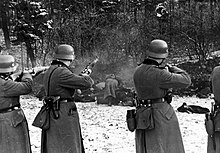Summary execution
In civil and military jurisprudence, summary execution is the putting to death of a person accused of a crime without the benefit of a
Summary executions have been practiced by
Military jurisdiction

Under
Prisoners of war
Major treaties such as the
No sentence shall be passed and no penalty shall be executed on a person found guilty of an offence except pursuant to a conviction pronounced by a court offering the essential guarantees of independence and impartiality.
— Second Protocol of the Geneva Conventions (1977), Article 6.2
Exceptions to prisoners-of-war status
However, some classes of


The Commando Order was issued by
According to Article 4 of the
Soldiers who are wearing uniforms of the opposing army after the start of combat may be considered illegal combatants and subject to summary execution. Many armies have performed that kind of false flag ruse in the past, including both German and US special forces during World War II. However, if soldiers remove their disguises and put on proper insignia before the start of combat in such an operation, they are considered legal combatants and must be treated as prisoners of war (POWs) if captured. That distinction was settled by a military tribunal in the postwar trial of Otto Skorzeny, who led Operation Greif, an infiltration mission in which German commandos wore US uniforms to infiltrate US lines during the Battle of the Bulge.[6]
Under martial law
Within a state's policy, martial law may be declared in emergencies such as invasions or insurrections, and in such a case constitutionally protected rights would be suspended. Depending on a state's interpretation of martial law, this may allow police or military forces to decide and carry out punishments that include death on its own citizens, in order to restore lawful authority or for other vital reasons.
That would not include killing a suspect who is directly endangering another's life, which is always legal for police, but executing a suspect under one's control as a punishment. Proving that a summary execution fell under the legal exception would be exceptionally difficult, as one would have to show why a judgment and sentence of death absolutely needed to be meted out on the spot. Hence, such extraordinary acts are almost always seen as illegal violations of human rights.
See also
- Encounter killings by police
- Extrajudicial punishment
- Extrajudicial killing
- Forced disappearance
- License to kill (concept)
- Lynching
- Retributive justice
- Vigilante
References
- ^ Ticehurst R (1997-04-30). The Martens clause and the laws of armed conflict. Int Rev RC #317, @ pp 125–134. Seen 2010-06-30.
- ^ Law Of The Sea.
- ^ USGPO Translation of order, UK: UWE, archived from the original on 2007-06-18
- ^ "The Commando Order", History learning site, UK
- ^ CAB/129/28, British National Archives,
... under which parachutists who were taken prisoner not in connection with battle actions were to be transferred to the Gestapo by whom they were, in fact, killed.
- ISBN 978-0-5218-7088-7.
